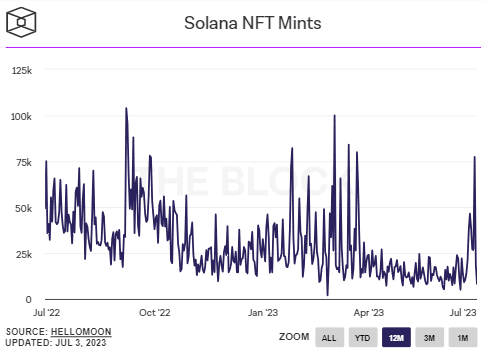NFTs
Are NFTs Dead or Just Breathing? Analyzing the Current State of the NFT Market
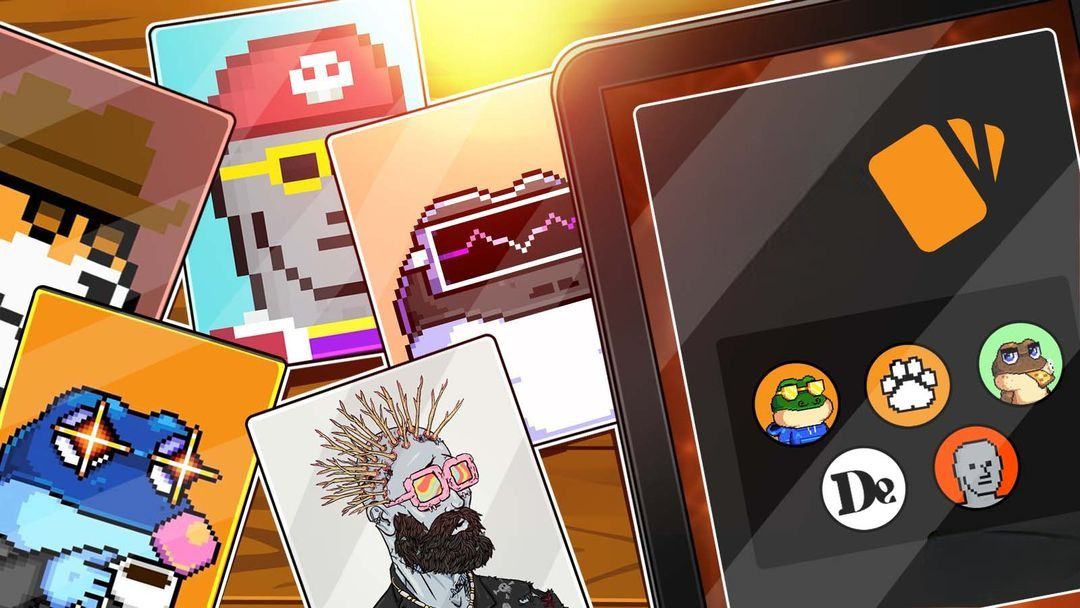
A substantial slowdown has hit the NFT sector, causing a decline in sales and price.
DR:
- The NFT market has experienced a significant downturn, marked by a drop in sales and prices.
- Factors contributing to the decline include speculative investments, scams and fraud, market oversaturation, and regulatory scrutiny.
- Despite the recession, there have been recent signs of a resurgence, with increased turnover and the emergence of new markets.
- The future of NFTs remains promising, with potential applications in digital identity verification, supply chain management, DeFi, virtual real estate, intellectual property rights, gaming, and the music and entertainment industry.
- NFTs are not dead, but evolving, and their long-term trajectory is still uncertain. Investors should exercise caution and conduct thorough research.
NFTs at a crossroads
The meteoric rise of Non-Fungible Tokens (NFTs) can be traced back to their introduction in 2014. Since then, they have captured the imagination of artists, collectors and investors.
However, this new enthusiasm around NFTs has not been without its fair share of controversies.
In recent months, the NFT sector has experienced a significant slowdown, marked by a drop in sales and item prices. What was once a booming market, with exorbitant amounts spent on popular NFT collectible projects, appears to have lost momentum.
Brands that hastily jumped on the NFT bandwagon are now reassessing their short-term goals. As crypto market sentiment remains bearish, the NFT landscape appears to be at a crossroads.
In this article, we’ll delve deeper into the current state of NFTs, analyzing the factors that have contributed to the market slowdown. We’ll explore the arguments for and against NFTs, examining potential growth opportunities and future challenges. Ultimately, we’ll attempt to answer the burning question: are NFTs dead, or are they simply facing a temporary setback?
The Hype and Initial Success
The concept of NFTs has gained momentum to bring scarcity and value to the digital world.
The NFT market has seen a surge in high-profile sales that have captured global attention in the second half of 2021. Notably, Beeple’s digital artwork, titled “Every Day: The First 5,000 Days,” sold for a whopping $69 million, propelling NFTs into the mainstream. This unprecedented sale highlighted the potential for digital art to command significant market value.
Another notable example is Pak’s “The Fungible Collection,” featuring the iconic “Clock” piece, which sold for $52 million. These high-profile sales solidified NFTs’ position as a lucrative investment opportunity.
Furthermore, the role of celebrities and influencers in promoting NFTs Celebrities and influencers played a key role in promoting the initial enthusiasm and popularity of NFTs. Prominent figures like Eminem and Jimmy Fallon have openly supported NFT projects like Bored Ape Yacht Club (BAYC), generating widespread attention.
During the same period, the rise of NFT marketplaces such as Open sea and Rarible, have made it easy to buy and sell NFTs, fueling interest and participation from experienced and novice collectors. The NFT space has gained so much attention that NFT volume on OpenSea exceeded $184 million in one day, with over 43 thousand active users.
OpenSea statistics over a year (Source)
During the height of the NFT frenzy, with record sales and celebrity endorsements, NFTs were on an unstoppable trajectory. However, as we explore the subsequent sections, we will discover challenges and controversies that have arisen, raising questions about the long-term sustainability of NFTs.
The Rise and Fall of NFTs: Understanding the Reasons Behind the Decline
Eventually, the euphoria died down, leading to a significant decline in the NFT market.
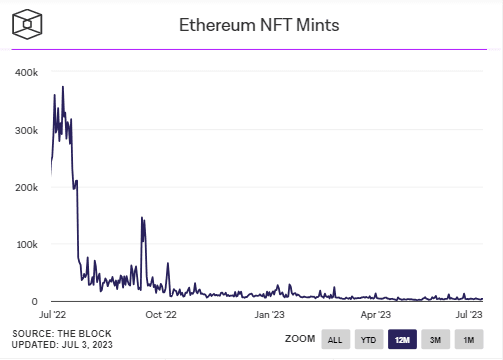 Ethereum NFT coins dropped from 373K on July 10, 2022 to 3.59K on July 1, 2023. (Source)
Ethereum NFT coins dropped from 373K on July 10, 2022 to 3.59K on July 1, 2023. (Source)
In addition to the broader market dynamics, there were unique challenges and issues that played a role in the downfall of NFTs:
1. The role of speculators and inflated prices: Some argue that the skyrocketing valuations of certain NFTs have been fueled by speculative investors rather than a genuine appreciation for the underlying art or digital assets. Additionally, volatility and uncertainty surrounding NFT prices have contributed to instability and risk in the market.
two. Increase in scams and fraud in the NFT market: With the exponential growth of the NFT sector, several smaller projects have emerged, some of which have turned out to be scams. Investors and collectors have fallen victim to “rug pulls,” where creators abruptly abandon scams, leaving participants with worthless or non-existent NFTs. These incidents have fueled a sense of distrust in the community, leading to broader skepticism about the legitimacy and reliability of NFT projects.
3. Market correction factors, including oversaturation Oversaturation played a crucial role in the NFT market correction. During the peak of NFT hype, several projects emerged, flooding the market with an abundance of digital assets. This saturation has made it challenging for investors and collectors to distinguish between high-quality NFTs and less valuable ones.
4. Regulatory analysis of NFT platforms and transactions: Governments around the world are grappling with how to regulate these digital assets, and new laws and regulations could have implications for NFT platforms and transactions. The prospect of increased regulation has created a sense of caution among investors, further contributing to the market correction.
As a result of all these factors, the NFT market has experienced a significant downturn, marked by a decline in both sales and prices. To give you an idea, in January 2022, Justin Bieber purchased this Bored Ape NFT for US$1.31 million. He is currently worth less than $59,000.

The NFT market’s total trading volume fell from $10.7 billion in Q4 2022 to $4.7 billion in Q1 2023, representing a staggering 53% drop, according to a DappRadar Report.
NFTs are dead
By examining the current state of the NFT market and comparing it to historical performance, we can determine whether NFTs are dead or still thriving.
After experiencing a decline in trading volume for several months, there was a notable reversal in January, with a 38.5% increase compared to the previous month. This trend continued in February, with trading volume reaching a staggering $2 billion, an increase of 111% compared to the previous month. This spike in trading volume was largely driven by the emergence of Blur, a new marketplace that has quickly gained traction within the NFT ecosystem, and the emergence of BRC-20 NFTs.
Interestingly, despite a decrease in sales count from 9.2 million in January to 6.3 million in February, the average selling price of NFTs has increased to accommodate the substantial increase in trading volume.
Despite high transaction costs and scalability challenges, Ethereum accounted for $1.8 billion in trading volume in February, demonstrating its continued dominance. On the other hand, Solana accounted for $75 million in trading volume during the same period, indicating its growing popularity as a viable NFT network. The number of NFT coins on Solana has also remained relatively stable.
Despite February’s impressive spike, it falls short of the record-breaking month of January 2022, when more than $5.5 billion worth of NFTs were traded across major markets. However, the recent resurgence in trading volume and the presence of new markets demonstrate that there is still life and potential for growth in the NFT market.
Future of NFTs
While the NFT market is undergoing a correction and moving away from its initial speculative hype, the future of NFTs remains bright. Furthermore, advancements in blockchain technology, such as Ethereum’s Layer 2 solutions, improve the accessibility of NFTs by reducing environmental impact and transaction costs.
Looking ahead, the unique utility of NFTs to establish ownership and authenticity in the digital world presents countless innovative applications across industries. Here are some potential uses:
Digital Identity Verification: NFTs can be used to represent digital identities, increasing the security and reliability of online interactions. This technology has the potential to prevent fraud and secure digital transactions.
Supply chain management: By attaching NFTs to products, consumers can verify their authenticity and track their origin and journey through the supply chain, promoting transparency and trust.
Decentralized Finance (DeFi): NFTs can be used as collateral for loans or to represent stakes in investments, expanding the possibilities of DeFi.
Virtual real estate and metaverse: As the metaverse concept develops, NFTs will increasingly be used to own and trade land, buildings and other virtual assets in virtual worlds like Decentraland and Cryptovoxels.
Intellectual property right: NFTs can change the way intellectual property is bought, sold and managed by representing ownership of patents, trademarks and copyrights.
Games: NFTs allow players to own and trade in-game assets independently of game developers, monetizing their virtual skills.
Music and entertainment industry: Artists and creators can leverage NFTs to directly sell music tracks, videos, or exclusive experiences to fans, enabling greater control and direct interaction with their audiences.
NFTs: Not Dead, But Evolving
The potential for NFTs to become more popular in the future is significant. Factors such as infrastructure development, the scarcity of NFTs, diversification opportunities, growing adoption across different sectors, and growing acceptance by traditional artists and brands contribute to the NFT market’s potential for recovery and prosperity.
The recent increase in trading volume and continued interest in NFTs demonstrate that there is still value and potential in this digital asset class. However, it is important to note that the market is still evolving and its future trajectory remains uncertain. Investors should exercise caution, conduct thorough research, and understand the dynamics of the NFT market before entering into any transaction.
In conclusion, although NFTs have experienced a decline, they are not dead. It will be interesting to see how the NFT landscape evolves and how this unique asset class continues to shape the digital economy.
NFTs
RTFKT Announces Project Animus Reveal, Launches Egg Unboxing Event Amid Mixed Reactions | NFT CULTURE | NFT News | Web3 Culture
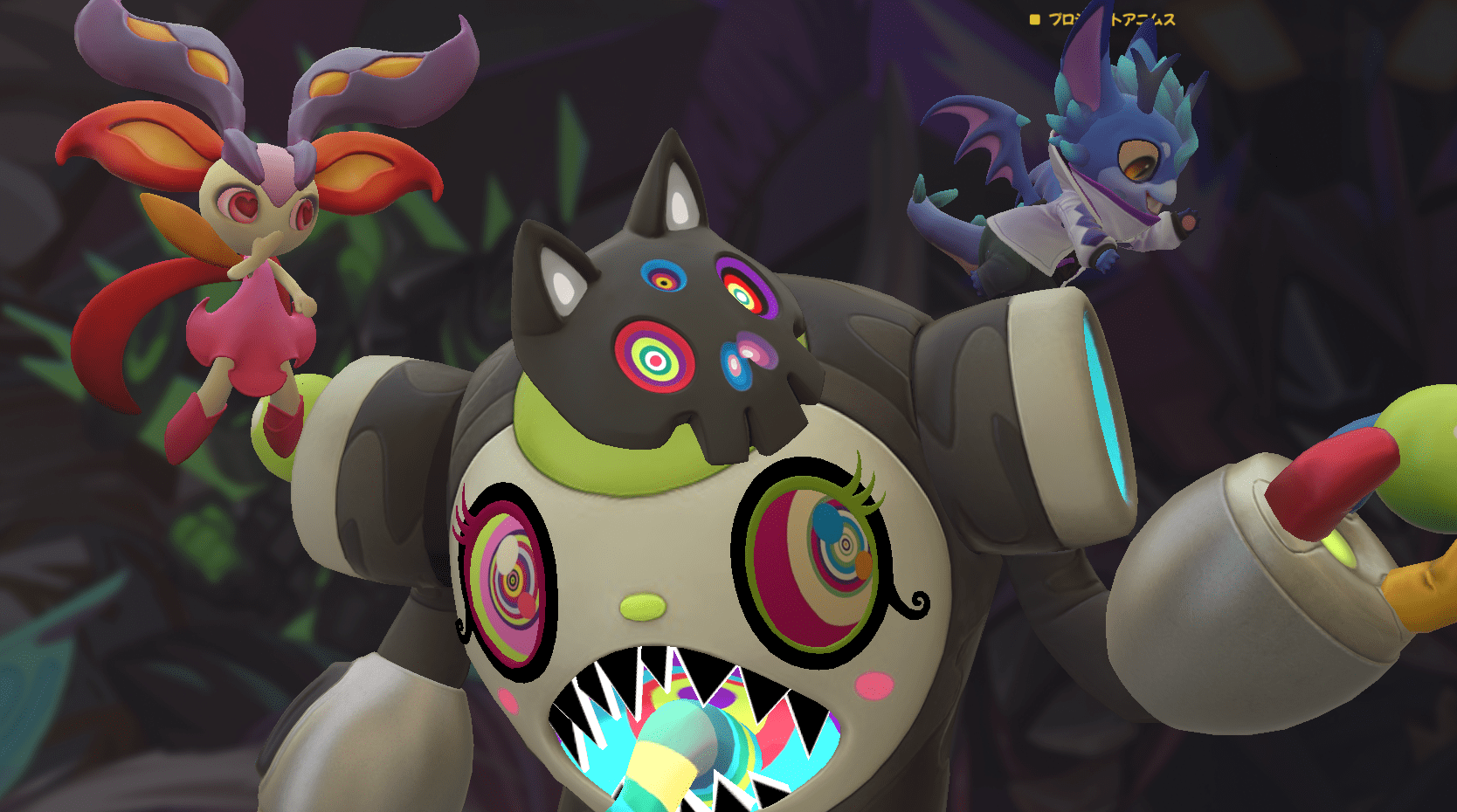
RTFKT, the innovative creator-led company renowned for its cutting-edge sneakers and metaverse collectibles, has officially unveiled its highly anticipated collection, Project Animus. This project marks a significant milestone in RTFKT’s journey, introducing a new dimension to its digital universe after a long period of development. However, the initial market response has been disappointing, with the revealed Animi trading at a floor price of 0.05 ETH, significantly lower than the eggs’ floor price of 0.09 ETH.
The Genesis of the Project Animus
Initially introduced in October 2022, Project Animus introduces a unique ecosystem of digital creatures called Animi. These Animi are designed to enhance Clone X’s avatars, offering an immersive and engaging experience for the community. The recent reveal showcased a diverse range of Animi species, each with distinct design traits and elemental attributes, breaking away from traditional trait-based rarity systems.
A New Digital Frontier: The History and Evolution of Project Animus
The Animus Project is RTFKT’s latest intellectual property, promising to revolutionize the NFT space with its unique digital creatures. The journey kicked off on October 8, 2022, with an interactive teaser event called “The Eggsperience.” This livestream event allowed attendees to explore a virtual Animus Research Facility, generating intrigue and excitement among the community.
Renowned artist Takashi Murakami played a significant role in the project, revealing the first Murakami-themed Animus creature, Saisei, on April 30, 2023. This collaboration added a layer of artistic prestige to the project, further elevating its status within the NFT community.
Animus Egg Incubation: A Journey from Egg to Animi
Clone X NFT holders had the opportunity to claim an Animus Egg until March 1, 2024. This was followed by the Animus Egg Hatching event, which ran from May 7 to June 4, 2024. During this period, holders of several RTFKT NFTs, including Clone X, Space Pod, Loot Pod, Exo Pod, and Lux Pod, were able to use a points-based system to increase their chances of hatching rarer Animi. The limited supply of Project Animus Eggs is capped at 20,000, with no public sale planned.
Mixed market reception
Despite the excitement and innovative features, the market reaction to the reveal of Project Animus has been lukewarm. Animi is currently trading at a floor price of 0.05 ETH, significantly lower than the eggs’ floor price of 0.09 ETH. This discrepancy has led to disappointment among some collectors who had high expectations for the project.
What Awaits Us: The Future of Project Animus
Following the reveal, RTFKT plans to release a collection of exclusive Animus Artist Edition characters. Holders of Clone X Artist Edition NFTs are guaranteed to get one of these special editions. The distribution will include 88 Special Edition Animus, with 8 Mythic (Dragon Sakura), 40 Shiny, and 40 Ghost Animus. The odds of receiving a Special Edition Animus are the same for all Eggs hatched, regardless of the points accumulated.
The remaining Animus characters will be distributed among unhatched Eggs, encompassing Special Edition Animus, as well as Cosmic Animus and Murakami Element from Generation 1, Generation 2, and Generation 3.
Conclusion
RTFKT’s Project Animus represents a bold step forward in the NFT space, combining cutting-edge technology with artistic collaboration to create an immersive and innovative digital ecosystem. However, the initial market reception highlights the challenges of living up to high expectations in the ever-evolving NFT landscape. As the project continues to evolve, it promises to deliver unique experiences and opportunities for its community, solidifying RTFKT’s position as a leader in the metaverse and digital collectibles arena.
Summary: RTFKT has unveiled Project Animus, introducing a unique ecosystem of digital creatures called Animi designed to enhance Clone X avatars. Despite the excitement, market response has been mixed, with Animi trading at a lower floor price than eggs. The project kicked off with an interactive event in October 2022, featuring collaborations with artist Takashi Murakami. Following the reveal, RTFKT will release special edition Animus characters. The total supply of Animus Eggs is limited to 20,000, with no public sale planned.
NFTs
The Olympics have reportedly ditched Mario and Sonic games in favor of mobile and NFTs
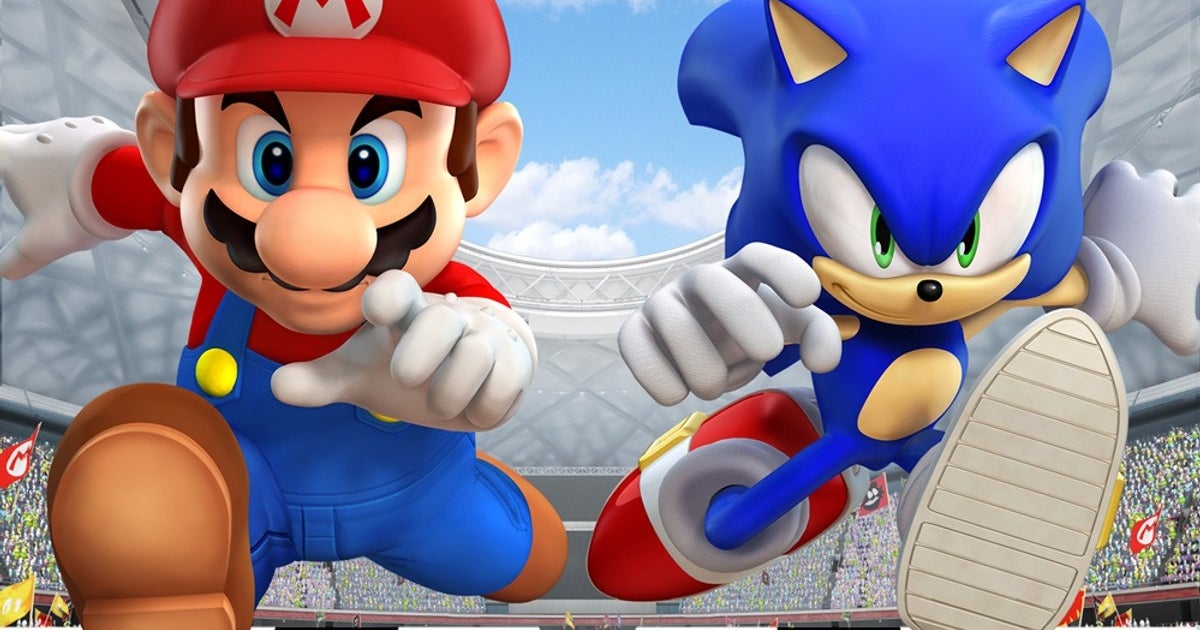
The long and historic partnership between Nintendo and Sega to create video games for the Olympics reportedly ended in 2020 as event organizers sought opportunities elsewhere.
Lee Cocker, who served as executive producer on several Mario & Sonic Olympics titles, said Eurogamer the International Olympic Committee let the licensing agreement lapse because it “wanted to look at other partners, NFTs and esports.”
“Basically, the IOC wanted to bring [it] “Turn inward and look for other partners so you can get more money,” Cocker added.
The 2024 Summer Olympics kicked off in Paris last week, but there were no Mario & Sonic games available in time for the event to begin – the first time this has happened since the original release in 2007 to coincide with the 2008 Beijing Summer Olympics.
Over the past two decades, there have been four Mario and Sonic adaptations for the Summer Olympics, as well as two for the Winter Olympics.
This year, instead of a Nintendo/Sega title, the IOC released Olympics Go! Paris 2024, a free-to-play mobile and PC title developed by nWay, which has worked on several Power Rangers games.
Olympics Go! allows players to compete in 12 sports and unlock NFTs from the Paris 2024 digital pin collection.
The original Mario & Sonic at the Olympic Games was announced in March 2007 and marked the first time the two mascots – once archrivals in the console wars of the 1990s – appeared together in a game.
NFTs
DraftKings abruptly shuts down NFT operation, leaving collectors panicking over vast holdings of digital tokens
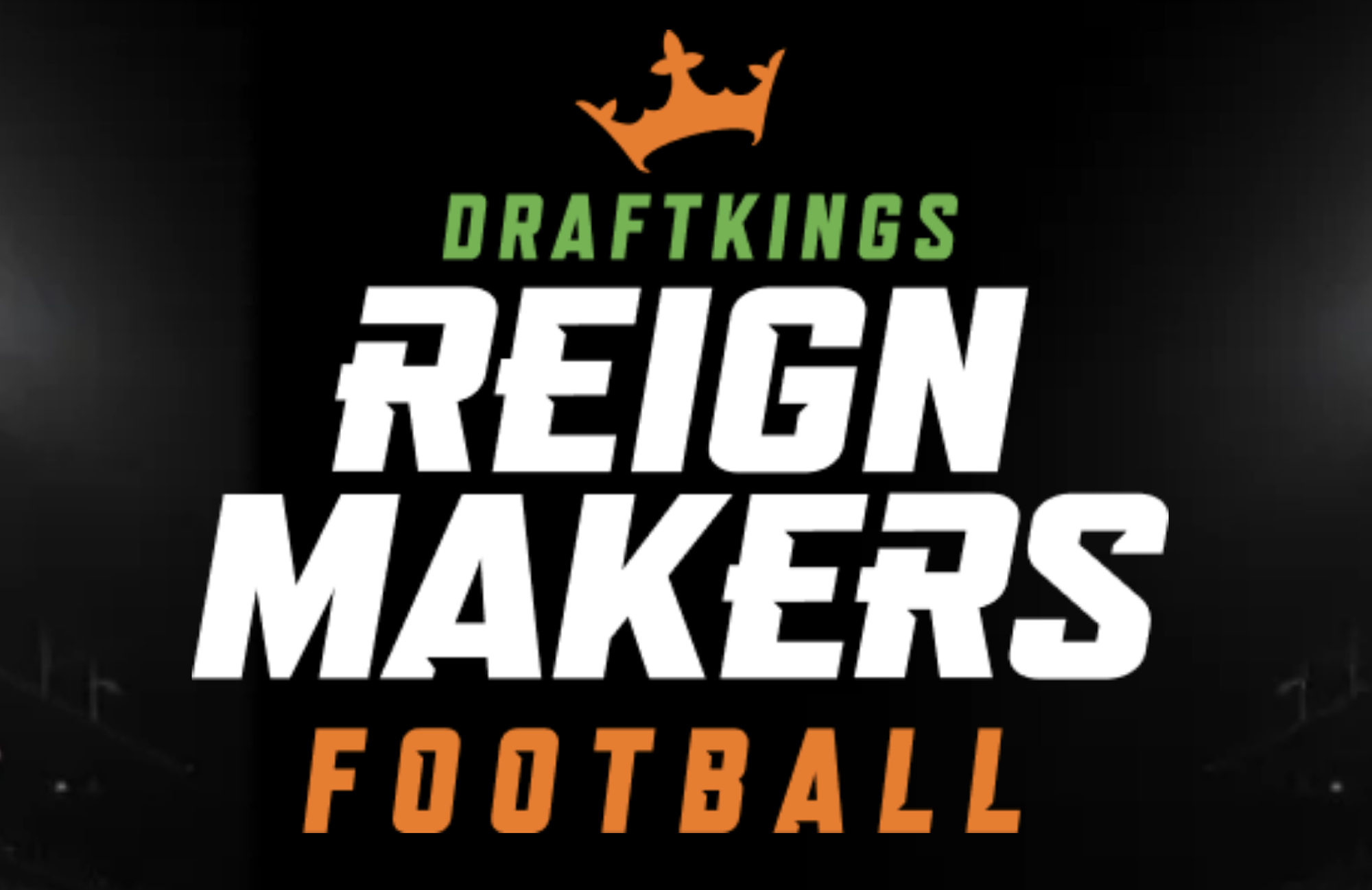
DraftKings, the daily fantasy sports and sports betting company, abruptly shut down a program called Reignmakers on Tuesday, posting a notice on its website and associated app and sending a mass email to some subset of its user base. Reignmakers, which the company launched in 2021, offered pay-to-play competitions in NFL football, PGA Tour golf and UFC mixed martial arts. The decision to eliminate the entire program, DraftKings says, was not made lightly but was forced “due to recent legal developments.”
DraftKings has yet to specify what “recent legal developments” are troubling its now-dead Reignmakers product. The company was sued in U.S. District Court in 2023 by a Reignmakers player named Justin Dufoe, who accuses the company of dealing in unregistered securities, taking advantage of relatively unsophisticated “retail investors,” and failing to market and support Reignmakers to the degree necessary to return to its users the financial benefits expected. DraftKings filed a motion in September to dismiss Dufoe’s complaint, but that motion was denied on July 2. A scheduling conference was held by the parties on July 29; Reignmakers was permanently shut down on July 30. A DraftKings spokesperson reached by Defector on Wednesday declined to confirm whether Dufoe’s complaint is the “recent legal development” that forced the company’s hand.
Users of the Reignmakers NFL product, who in recent days began murmuring on social channels about a notable lack of DraftKings activity so close to the start of the NFL preseason schedule, were caught off guard and, in some cases, devastated by the news. Members of the DraftKings Discord server, where all Reignmakers-related channels were abruptly shut down and locked following the announcement, flooded a general channel in various states of panic, sharing news, theorizing, lamenting, and, in some cases, openly worrying about whether it would be possible to recoup any decent fraction of the genuinely impressive sums of money they had invested in this DraftKings product.
Reignmakers is nominally a daily fantasy contest—users build lineups of players and then pit those lineups against other users’ lineups for cash prizes—but it’s actually a distributor of nonfungible digital tokens (NFTs), originated and sold by DraftKings, and then frequently resold on a dedicated secondary marketplace also hosted by DraftKings. At the lineup-building level, Reignmakers functions like a card-collecting game, with artificial scarcity driving the prices of the most coveted cards to insane, eye-popping heights. Reignmakers NFTs are tiered and offered in timed drops designed to heighten the sense of scarcity. A user can enter a lower-tier contest using a collection of NFTs that may have cost a few hundred dollars in total (or that were earned by purchasing random packs of NFTs that offer generally low odds of scoring top assets) and throw their lot in with hundreds of casual users competing for relatively unimpressive rewards. Random packs at the lowest tier would have prices as low as a few dollars; mid-tier cards—Star and Elite tiers, I’d guess—could cost a player upwards of $1,000.
But players interested in hunting down the biggest payouts, not just from games but from leaderboard prizes and other assorted prizes, would need to enter higher-tier games, and to enter the higher-tier games, a user’s collection needed to include higher-tier NFTs. DraftKings ensured that these cards were extremely scarce and could only be purchased directly on the marketplace at prices that any reasonable person would consider utterly insane.
For example, the highest-tier Reignmaker contests (called the Reignmakers tier, of course) have in the past been limited to listings with at least two of the highest-tier, rarest NFTs (also the Reignmaker tier) plus three NFTs from the second-highest tier (Legendary). NFTs at these tiers are expensive. Not just expensive in the way that, like, a steak dinner is expensive, but expensive in the way that buying even one of them should trigger a mandatory visit to a gambling addiction counselor, if not sirens and a straitjacket. Back in 2022a Reignmaker-level Ja’Marr Chase NFT from something called the Field Pass Promo Set could be purchased directly from the DraftKings Reignmaker Marketplace for a whopping $32,100.
Reignmakers users purchased NFTs at various levels with the expectation that owning them would convey better odds of winning contests hosted on DraftKings. This was the gamification element of Reignmakers, which emerged several months after DraftKings began trading and minting its NFTs. But as with all NFTs, a very large part of the real appeal for its buyers was the expectation, however insane, that these worthless, virtually worthless, infinitely duplicable digital images would increase in value over time. Now that both the Reignmakers game and the Reignmakers marketplace have been shut down, Reignmakers NFT holders are worried that their investments may have suddenly lost all monetary value. One Discord user described Tuesday as “a bad day to wake up and realize you have $2,000 worth of unopened NFL Rookie Packs”; Another user asked the group if they should expect “a refund” on the $10,000 they’ve already spent on Reignmakers NFTs this year. A pessimistic Reddit user posted tuesday that they would sue DraftKings if they were forced to take a total loss on a Reignmakers NFT collection worth approximately $100,000.
The game (scam?) was built to make numbers like these not only possible, but somewhat easily achievable. A user who intended to compete from a position of strength in multiple overlapping high-profile contests at the same time, and who had been in the blockchain madhouse for a period of years, could easily have spent six figures on Reignmakers NFTs. DraftKings used non-gaming incentives to entice players to spend more and more money, much like casinos give away free suites to players who over-bet on blackjack. Another Reddit user lamented the loss of the additional prizes and ranking bonuses he had hoped to earn in the upcoming NFL season by having a portfolio of NFTs that had reached the highest levels of value and prestige. “I was already loaded up on 2024 creation tokens and rookie debut cards,” said this Reignmakers userwho claimed his portfolio was finally “close to the top 250 overall.”
Dufoe’s complaint says the NFTs minted by DraftKings for Reignmakers qualify as securities, function like securities, and should be regulated as securities. In its motion to dismiss, DraftKings attempted to position its NFTs as game pieces — eye-wateringly expensive, yes, but essentially the same thing as Magic: The Gathering cards or Monopoly hotels. The court, in resolving these arguments, applied what’s known as “the Howey test,” referencing a case from 1946 in which the U.S. Supreme Court established a standard for determining whether a specific instrument qualifies as an investment contract. Judge Dennis J. Casper, in ruling against DraftKings’ motion, concluded that Dufoe could plausibly argue that Reignmakers’ NFT transactions represent “the pooling of assets from multiple investors in such a manner that all share in the profits and risks of the enterprise,” arguing that DraftKings’ absolute control over the game and marketplace effectively binds the financial interests of the company and the buyers, the latter of whom depend on the viability of both for their NFTs to retain any value.
Reignmakers users are different from Monopoly players in at least one crucial way: A person who buys a Monopoly board has no expectation from Hasbro that those little red and green pieces will appreciate in value. It’s a game! No matter what any hysterically conflicted party may say to the contrary, that’s not what NFT collecting is. DraftKings had been selling Reignmakers NFTs for months before they were gamified, and Dufoe, in his complaint, cites public comments made by DraftKings spokespeople that seem to explicitly position Reignmakers NFTs as assets with independent monetary value beyond their utility in Reignmakers contests. Judge Casper, in his ruling on the motion to dismiss, cites a Twitter account associated with a podcast run by DraftKings CEO Matthew Kalish, who in a tweet described NFTs as “the opportunity to invest in startups, artists, operations, and entrepreneurs all at once.” This is probably the kind of thing that NFT peddlers should stop saying. This advice assumes, of course, that NFTs will continue to exist as instruments on the other side of this and other lawsuits.
DraftKings has posted a worryingly sparse FAQ at the bottom of the your ad Tuesday, anticipating but largely failing to address questions from players who see this as yet another in a long line of brutal blockchain rug pulls. In a hilarious reversal of existing Reignmakers policy, Reignmakers users are now allowed by DraftKings to withdraw their Reignmakers NFTs from their DraftKings portfolios and into their personal NFT wallets, where those NFTs will have precisely zero value, to anyone, for the rest of all time. There’s also vague language about Reignmakers users having the option to “relinquish” their NFTs back to DraftKings in exchange for “cash payments,” subject to “certain conditions” and according to an as-yet-unspecified formula that will take into account, among other things, the “size and quality” of a player’s collection.
Reignmakers users are not optimistic. Those who claim to have been victims of other blockchain market crashes are warning their peers on Discord and Reddit to expect payouts that amount to pennies on the dollar; in the absence of any clarifying information, users are unsure whether cashing out their NFTs from Reignmakers to their personal NFT wallets, for reasons that completely pass any and all understanding, would effectively preclude the possibility of delivering these silly digital tokens back to DraftKings. It remains to be seen what exactly DraftKings has in mind with the “certain conditions” attached to the delivery process. There is much that has yet to be resolved. A DraftKings spokesperson contacted by Defector indicated that more time would be needed to answer a list of specific questions and issued a statement noting that it is “in DraftKings’ DNA to innovate and disrupt to provide the best possible gaming experiences for our customers.” The original complaint is embedded below.
Do you know anything about the demise of Reignmakers, either from the consumer side or from the DraftKings side? We’d love to hear from you. Get it in touch!
Recommended
NFTs
There Will Be No More ‘Mario & Sonic’ Olympics Because of NFTs
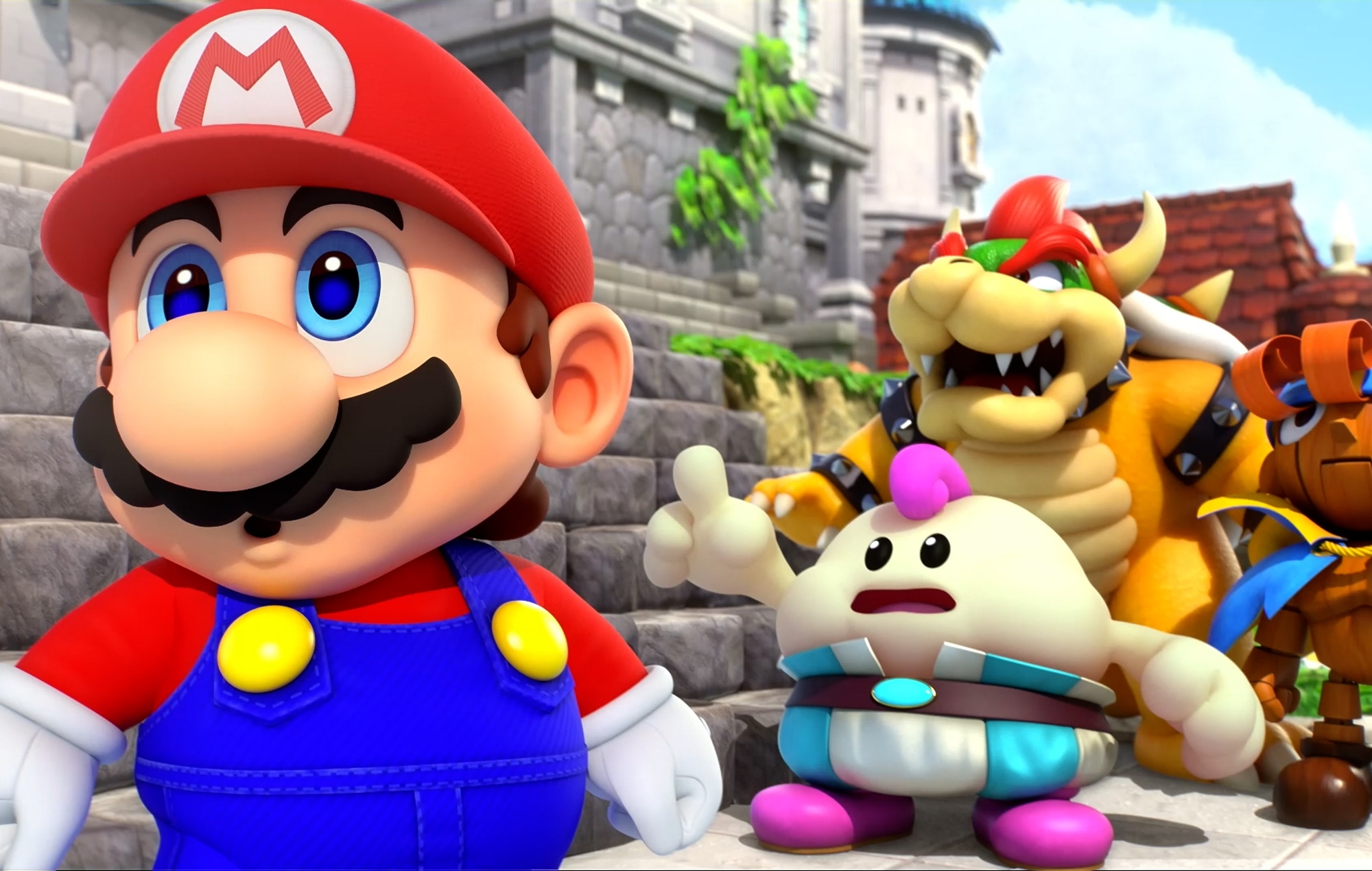
Nintendo and SEGA have been teaming up with the Olympics for several years now in the popular Mario & sonic in the Olympic Games series, but a new report claims the International Olympic Committee has abandoned the series in favor of new deals in eSports and NFTs.
According to Eurogamer“A veteran behind the series,” Lee Cocker, told the outlet that the IOC chose not to renew its license with SEGA and Nintendo, letting it expire in 2020. “They wanted to look at other partners and NFTs and eSports,” Cocker told Eurogamer. “Basically, the IOC wanted to bring [it] turn inward and look for other partners so they could get more money.”
Mario & Sonic at the Olympic Games is a series that has been running since 2008, with six main games covering the regular and Winter Olympics. In the games, players could control various characters from the Mario and Sonic franchises and compete in Olympic sporting events.
It’s no secret that NFTs are a big part of this year’s Paris 2024 Olympics. Olympics Go! Paris 2024 is a mobile and mobile-connected game your site states that players can “join the excitement of the Paris 2024 Olympic Games with nWay’s officially licensed, commemorative NFT Digital Pins collection honoring Paris 2024!”
As for eSports, Saudi Arabia will host the ESports Olympic Games in 2025. This is part of a partnership with the Saudi National Olympic Committee (NOC) that is expected to last for the next 12 years and is expected to feature regular events.
IOC President Thomas Bach said: “By partnering with the Saudi NOC, we also ensure that Olympic values are respected, in particular with regard to the game titles on the programme, the promotion of gender equality and the engagement with young audiences who are embracing esports.”
In other news, Someone claimed they’re suing Bandai Namco because Elden Ring is too difficult.
-

 News7 months ago
News7 months agoMore Crypto AI Alliances Emerge Following $7.5 Billion Token Merger — TradingView News
-

 News7 months ago
News7 months agoOver 1 million new tokens launched since April
-

 Videos8 months ago
Videos8 months agoMoney is broke!! The truth about our financial system!
-
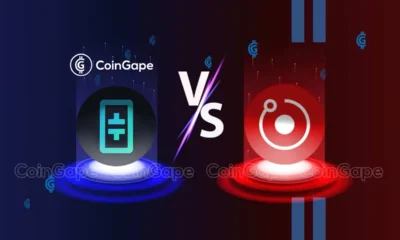
 Altcoins7 months ago
Altcoins7 months agoRender vs. Theta; Which DePIN Altcoin to buy in May
-
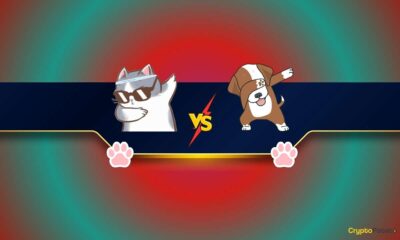
 Memecoins7 months ago
Memecoins7 months agoChatGPT Analytics That Will Work Better in 2024
-
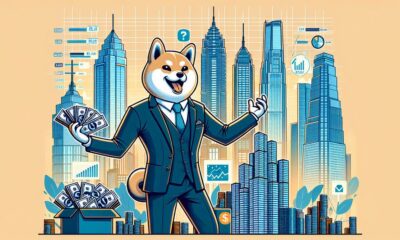
 Altcoins7 months ago
Altcoins7 months agoAltcoin Investments to create millionaires in 2024
-

 NFTs8 months ago
NFTs8 months agoSurprisingly, Bored Apes is now laying off employees as the NFT market disintegrates
-

 Videos7 months ago
Videos7 months agoFantom: Potential FTM Price and BIG Updates – The Latest!!
-
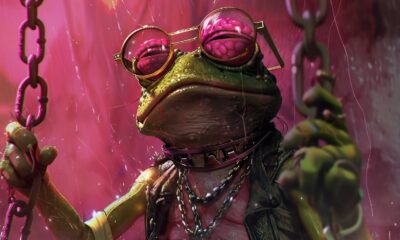
 News5 months ago
News5 months agoInvest Now: The Hottest New Cryptocurrencies of August 2024 That Could Skyrocket
-
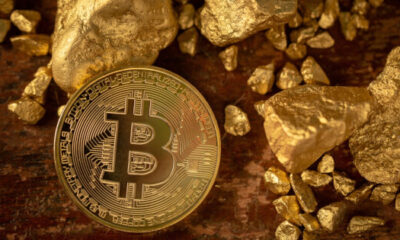
 Memecoins5 months ago
Memecoins5 months agoMemecoins dominate major derivatives in terms of open interest | Flash News Detail
-
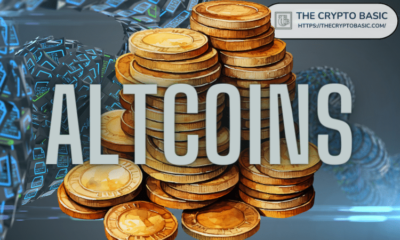
 Altcoins5 months ago
Altcoins5 months agoOn-chain data confirms whales are preparing for altcoin surge with increased buy orders
-
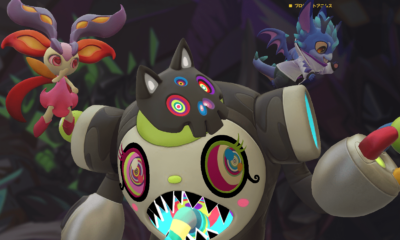
 NFTs5 months ago
NFTs5 months agoRTFKT Announces Project Animus Reveal, Launches Egg Unboxing Event Amid Mixed Reactions | NFT CULTURE | NFT News | Web3 Culture

